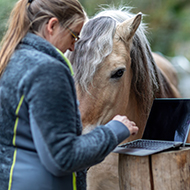
Researchers create artificial dog nose using 3D printer
Current technologies that rely on continuous suction to detect explosives could be improved by ‘active sniffing’ - a technique used by dogs to pick up certain smells.
In a study, US researchers fitted a dog-nosed inspired adapter to the front of a commercially available explosives detector.
They found that adding the artificial nose to enable active sniffing improved the detection of odour by up to 18 times.
“The dog is an active aerodynamic sampling system that literally reaches out and grabs odourants,” explained Matthew Staymates, a mechanical engineer and fluid dynamicist at the National Institute of Standards and Technology (NIST).
“It uses fluid dynamics and entrainment to increase its aerodynamic reach to sample vapours at increasingly large distances. Applying this bio-inspired design principle could lead to significantly improved vapour samplers for detecting explosives, narcotics, pathogens—even cancer.”
Carried out by researchers from NIST, the Massachusetts Institute of Technology’s Lincoln Laboratory and the U.S. Food and Drug Administration, the study aimed to uncover clues on how to improve the capabilities of trace detection.
Turning to one of nature’s best chemical samplers, the dog, the team refined what occurs during sniffing. Every five seconds, dogs exhale to reach out, pull and then inhale to deliver a nose full of smells. The aromas are then decoded by around 300 million receptor cells.
The team used a 3D printer to replicate the features of a female Labrador retrievers nose, including the direction, shape and spacing of the nostrils. Inhaling and exhaling air through the artificial nose at the same rate of a dog, enabled the team to mimic the air sampling - or sniffing action - of dogs.
“Their incredible air-sampling efficiency is one reason why the dog is such an amazing chemical sampler,” added Stalemates. “It’s just a piece of the puzzle. There’s lots more to be learned and to emulate as we work to improve the sensitivity, accuracy and speed of trace-detection technology.”
The study, Biomimetic Sniffing Improves the Detection Performance of a 3D Printed Nose of a Dog and a Commercial Trace Vapor Detector, is published in Scientific Reports.



 With Strangles Awareness Week just around the corner (5-11 May), vets are being encouraged to share a survey about the disease with their horse-owning clients.
With Strangles Awareness Week just around the corner (5-11 May), vets are being encouraged to share a survey about the disease with their horse-owning clients.